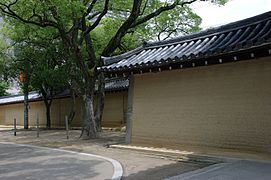Nishinomiya Shrine
The Nishinomiya Shrine ( Japanese 西宮 神社 , Nishinomiya-jinja ) is a shrine in Nishinomiya , Hyōgo Prefecture , Japan . It is the main shrine of the Ebisu branch within the Shinto , which is said to include 3,500 shrines, and namesake for the place.
Overview
Nishinomiya Shrine is also called Epessan ( え べ っ さ ん ) because it is widely known as the main general shrine of Ebisu. The shrine was created in 1872 by splitting off from the Hirota Shrine . The origin of the shrine is not known in detail, but it is believed that since the Muromachi period, people have worshiped the Ebisu as the god of fishing and trade.
In the Edo period , puppeteers ( 傀儡 師 Kugutsu-shi ) spread the shrine's fame across Japan. Nowadays, the Ten-Day Ebisu ( 十 日 え び す Tōka Ebisu ) festival is held from January 9th to 11th every year . In addition, there are a million visitors every year.
The attachment
The main hall of the shrine ( 本 殿 , Honden ; 1), together with the prayer hall ( 拝 殿 Haiden ; 2), was a national treasure , but was lost by fire in 1945. The current building is a reconstruction from 1961. The Honden consists of three halls: in the first Ebisu or Hiroko no Mikoto ( 蛭 児 命 ) is venerated, who is said to have come from afar across the sea . The fishermen of Naruo ( 鳴 尾 ), now part of the city, are said to have worshiped him first. The other large buildings of the shrine (yellow on the plan, marked with 4) indicate its importance. As part of the festival of Mikoshiya ( 御 輿 屋 ) , portable shrines ( Mikoshi ) are carried through the city every June . The sun deity Amaterasu and the earth deity Ōkuninushi ( 大 国 主 ) are worshiped in the second hall, and Susanoo in the third hall .
On the shrine grounds is the Rokueidō ( 六 Plan), 5 on map), which once belonged to the important politician of the Meiji period , Iwakura Tomomi . In 1971 the pavilion was moved here from Tokyo. There are also a number of inscribed memorial stones on the site. - The Shaso grove ( 社 叢 ; 6), which includes the shrine to the north and west, is registered as a natural monument of the prefecture.
The large front gate ( 表 大門 Omote daimon ; important cultural asset = ◎; 7) comes from the Muromachi period . Toyotomi Hideyori had it restored in 1604. The bell, the inscription of which indicates the year 1610, was donated by the daimyo and general Katagiri Katsumoto ( 片 桐 且 元 ; 1556–1615). Another architectural monument is the long wall ( 大 練 塀 ; Ōneribei ; marked in light brown; ◎) from the early Muromachi period that surrounds the shrine in the southeast. It is one of the "Three Great Walls" in Japan.
The summer festival, which is also called the Yukata festival after the light cotton garment, is held in the evening. Another festival will take place on September 22nd. Since the formal men's clothing " Hakama " ( 袴 ) was worn from that day on , the festival is also known as the Hakama festival.
photos
Remarks
- ↑ The horizontally ending cross gables indicate that a female god is worshiped here. See Japanese Shrine Architecture # Decoration .
- ↑ The name of the pavilion is derived from the 6 important politicians of the early Meiji period: In addition to Iwakura, we mean Sanjō Sanetomi , Saigō Takamori , Ōkubo Toshimichi , Kido Takayoshi and Itō Hirobumi .
- ↑ The other two are the Nobunaga Wall ( 信 長 堀 ; Nobunagabori ) at the Atsuta Shrine in Nagoya and the Daikōbei ( 大 閣 堀 ) of the Sanjūsangen-dō in Kyoto .
literature
- Hyogo no rekishi sampo henshu iinkai (Ed.): Nishinomiya jinja . In: Hyogo-ken no rekishi sampo (jo) . Yamakawa Shuppan, 2012, ISBN 978-4-634-24628-7 , pp. 70-72.
Web links
- Shrine website (Japanese)
Coordinates: 34 ° 44 '8.6 " N , 135 ° 20' 4.4" E






